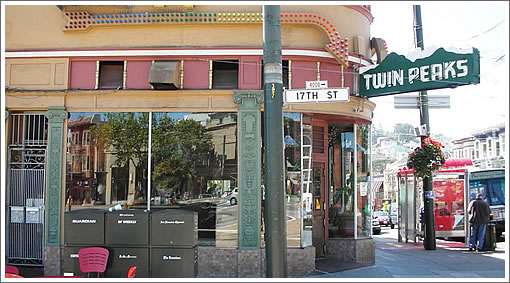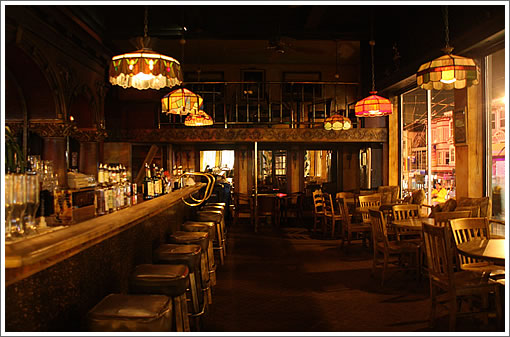
An old Irish dive bar with its windows covered so that “wives couldn’t see their husbands drinking” when purchased by two lesbians in 1972, the windows of the Twin Peaks Tavern at 401 Castro and 17th Streets were uncovered, becoming the first openly gay bar in San Francisco to reveal, rather than obscure, the view and views of its patrons.
The first known gay bar to feature full length open plate glass windows, the Twin Peaks Tavern is a living symbol of the liberties and rights gained by the lesbian, gay, bisexual, transgendered (LGBT) community in the second half of the 20th century…
Housed in a turn-of-the-century building with an intact 1923 Mediterranean Revival-style façade in the heart of the Castro, the bar retains its expansive windows and other character-defining features and continues to serve the LGBT community. The “U”-shaped bar is provided with a wooden foot rest, shaped wooden lip, and Formica top surface. Free-standing wood stools with vinyl upholstery surround three sides of the bar.

The more elaborate back bar is a pre-Prohibition piece of furniture. The unpainted wood lower section provides for open storage of liquor bottles, as well as closed cabinets and drawers. The upper section consists of three large arched openings with mirrored backs. Each arch sits on a squat wooden column with a gilt plaster composite capitol. The arches are adorned with additional plaster ornamentation. Stained glass pendant lamps hang within each arched opening.
Along with the Doegler Building, the Planning Department’s recommendation and case for the Twin Peaks Tavern to be designated as an official San Francisco Landmark will be considered by San Francisco’s Historic Preservation Commission this afternoon.
∙ The Prolific Henry Doelger And His Likely To Be Landmarked Building [SocketSite]
∙ Article 10 Landmark Case Report: Twin Peaks Tavern (401 Castro)[sfplanning.org]
Now, all Twin Peaks Tavern needs is non-1972 era glassware that serves 8-oz cocktails and we’re good to go!
They may want to reconsider covering those windows every time you lookout and see the naked guys at the parklet.
been walking by since 1985; my partner and i joke that we’re almost old enough to enter. it’s kind of like provincetown, with patrons aging more then the scenery.
40 years? What changes the Castro has seen, good and bad!
Quick, preserve this bar before it goes the way of The White Swallow on Polk, which has been lost to the ages.
Not nice to say, but we used to call it “the glass coffin”. It has a more mature clientele.
.. Or “Tomb with a view.” Mixed-younger clientele these days.
It’s much more mixed now (young/old/gay/straight). A lot of people use it as a casual place for an early drink before moving on for the night.
Personally I love it. Downstairs is jovial and has people watching and if you want a quiet chat with someone the mezzanine is secluded and has a great view of the action below.
Also huge plus is they have table service. Tip well!
My partner and I call it “god’s waiting room.”
Ageism is alive and well in enlightened SF. We’re all tired. The bar is landmarked because of clear glass?
Yes, I have heard the same comments by previous posters and thought them ugly and condescending.
While it wasn’t my scene, I could recognize people having fun and socializing with each other.
There does seem to more of a mix of ages now, possibly including the tourists getting off the F line to visit the Castro.
Does Landmark status mean the corner location can never be built higher?
Someday I aspire to be old (I think most of us do) so I try and brush off the stigma and hoist a few at this place from time to time. I like that SF has a gay scene that has at least some place for people who aren’t in their 20s and 30s; some cities don’t.
@Invented
“The bar is landmarked because of clear glass?”
Yes. It is the first gay bar in the country with windows open to the street.
“My partner and I call it “god’s waiting room.””
I laughed out loud at this!
Yeah, I’ve heard it called the Crystal Coffin, but I’ve gone there for beers around Castro shows and everybody’s always been totally cool, which seems a little odd in a place both so typecast and so centrally located.
Talk about a generation that refuses to let go. Why not let newer younger San Franciscans create their own space? Let the city change. If the Castro becomes an upper income “family” neighborhood, a new Castro will develop in another part of the city or beyond.
If Paris can let restaurants over 150 years old close and become new establishments, what makes San Francisco think it is so special?
Here here, anon2. The irony is that if this mad preservation dash had been in place 40 years ago, “the Castro” never would have been allowed to develop because the old, white, Irish neighborhood would have demanded that “their” history and culture be “preserved.”
A 40-year old landmark? Can I be designated a landmark as well?
If Paris can let restaurants over 150 years old close and become new establishments, what makes San Francisco think it is so special?
In Paris, the exterior has to stay the same, mostly due to historical preservation rules… The interior can be protected, if the place is put in the register of historical monuments. Every nail has to be approved by Monuments Historiques.
But no authority will ever tell you what kind of food or drinks you can serve inside.
Nethertheless, most of the older restaurants in Paris have managed to stay relevant by keeping high standards, marketing their authenticity, innovating, pooling resources with others. Also, people patronize them out of an attachment to the city an its lifestyle itself. Restaurants that cannot achieve that let the space to younger more aggressive entrepreneurs.
The Castro is changing a lot and it’s part of the cycle. Easy access to public transportation and fairly close freeway access are attracting a well off younger crowd, not necessarily gay. The Mission next door, Dolores Park, BV, proximity to Cole, Duboce and the Haight. It’s right in the middle of the new center of gravity of live/work/play SF.
What has changed in the Castro is the population, but NOT the buildings. I actually think the facades of the Castro look tired. Trying to “Save” the buildings will not save the atmosphere of the 70’s and will not recreate the nightlife that once was. The generation pushing these decisions needs to let go and allow this city to change and become young again.
Landmarking won’t preserve the use or the particularl clientele, so some of you are getting your panties all knotted up. And yes, as a gay man, I do have to say that being the first gay bar with plate glass windows is enough to make it a “historic landmark”. I think that makes it a worthy candidate.
We are one of the young families changing the demographics of the Castro, and while I believe it will continue to change in the way that lol suggests, and for the same reasons, I don’t have an issue landmarking Twin Peaks. We have a photo in our house of the intersection of Market/Castro dating from the 1940’s, and guess what – Twin Peaks was there then. This seems an appropriate designation. Now, what will change is the clientele, and that is happening all over the neighborhood, much as it is with the Mission, Divis/NOPA, etc. That is to be celebrated. But much as I loathe the ‘preserved in amber’ nature of many of these debates, this landmark seems to be appropriate.
Casting the net a bit wider, I think there’s also a point to be made that the specific history of the Castro means that stucco storefronts from the 70s are going to be its landmarks.
This historic Disneyland approach is bizarre. It would be like saving a rollercoaster that no longe works but was the fun 100 years ago. Let go people! There was just as much political GLBT groundbreaking done in Los Angeles and New York as there was in San Francisco yet those cities and communities have a much younger and better nightlife than the new Castro Historic District.
I would rather see new clubs, new music, new cafes than what some 60 year old got to enjoy 40 years ago.
One good thing about protecting the character of a neighborhood is that you can come back 30 years later and shoot a historical movie, like “Milk”.
It was probably very significant to the neighborhood that it could be shot on location.
Apart from that, houses are made for people and businesses to thrive in. If they do not fit the residents’ needs, they should be adapted or replaced.
NYC’s Stonewall Inn is a national historic landmark despite being a fairly recent recreation of and having no direct lineage to the original Stonewall. In comparison Twin Peaks is positively authentic.
You do understand that it’s not about the building right?
It’s about it’s historical significance within the LBGTQ community.
If you don’t understand how being the first gathering place for gay people to have windows open out onto the street is historical, you are living in the wrong neighborhood (city).
Neither here nor there on land marking it, but the twin peaks is pretty awesome, probably my favorite hangin out bar in the city, despite being neither gay nor old. It’s got great seating and atmosphere, good people watching and they mix up some good drinks.
Damn, should have landmarked the Mission so it would retain its Irish roots.
People keep assuming that Landmarking does something to preserve the cultural neighborhood. It does nothing of the sort…it preserves something physical. Presumably, in one hundred years, when the Castro is completely, say, Armenian families, there will be a nice corner bar with plate glass windows and perhaps a historical plaque acknowledging its importance. And that is fine. (see Harvey Milk’s camera shop, for instance SF Landmark #227….NOT still a camera shop,altered in most respects but still a pilgrimage site).